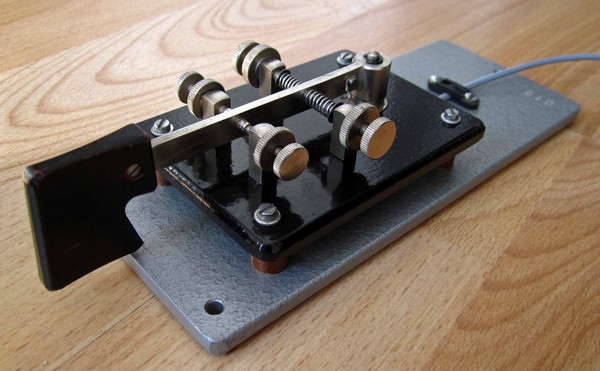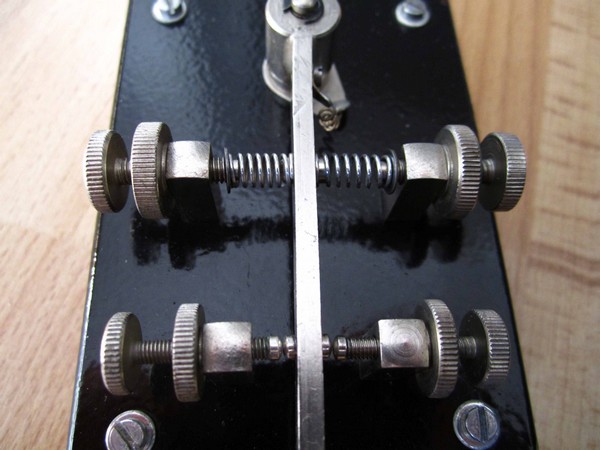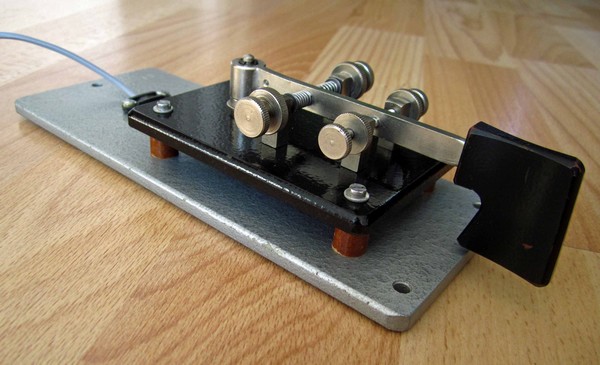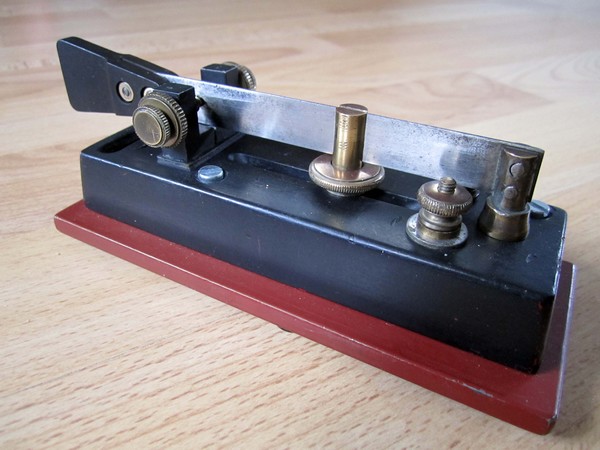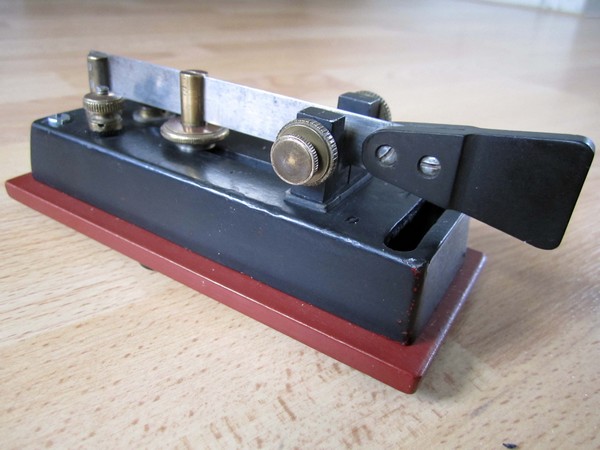PA3CVV's keys.
Begali HST key.
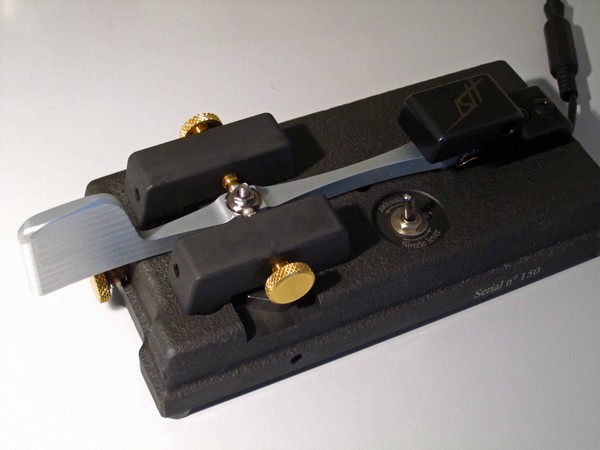 I loved operating the straight key until RSI (repetitive strain injury) in my right arm put paid to that. The iambic paddle poses less of a problem, but the glass arm is no match for the pump key. What to do? I tried the straight key with my left arm, but just couldn't get the hang of it. It is as if my right-hand memory gets in the way. I felt I was doing two things: learning left-handed, while 'unlearning' right-handed reflexes. So I decided to train the left hand with what was for me a new mode: side swiping. It is still not easy, but I think the theory might be right. The old synapses are slowly associating the cootie exclusively with the left hand. So much so that when I try side-swiping with my right hand it feels strange and unnatural. The key I opted for is the Begali HST, because it is beautiful, and because it has that handy switch for single lever operation. But I want to try some other cooties before deciding which one works best for me.
[PA3CVV].
I loved operating the straight key until RSI (repetitive strain injury) in my right arm put paid to that. The iambic paddle poses less of a problem, but the glass arm is no match for the pump key. What to do? I tried the straight key with my left arm, but just couldn't get the hang of it. It is as if my right-hand memory gets in the way. I felt I was doing two things: learning left-handed, while 'unlearning' right-handed reflexes. So I decided to train the left hand with what was for me a new mode: side swiping. It is still not easy, but I think the theory might be right. The old synapses are slowly associating the cootie exclusively with the left hand. So much so that when I try side-swiping with my right hand it feels strange and unnatural. The key I opted for is the Begali HST, because it is beautiful, and because it has that handy switch for single lever operation. But I want to try some other cooties before deciding which one works best for me.
[PA3CVV].
TWanger Sideswiper by TW Radio.
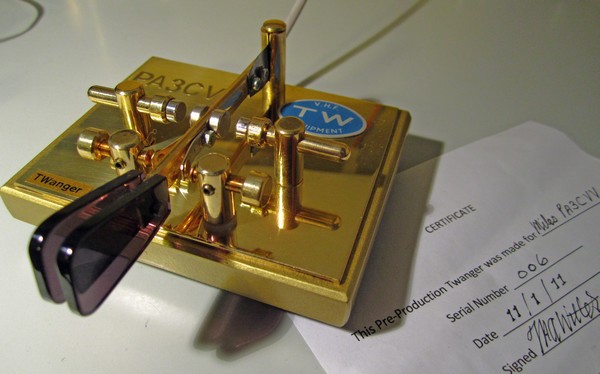 And here is my second cootie. Number 6 of the TWanger line produced by G3HGE / Tom. Quite unique in Swiper Land. The attachment to the pole is traditional, with a small strip of flexible metal. But in addition two strong magnets keep the arm central and dampen vibrations, while the contacts on the arm are placed on extending metal strips, giving a soft, smooth feel as they hit their opposite stationary contacts. I think it will take over from the Begali, which is a great key for single lever operators, but perhaps a bit 'clunky' for side swiping. The finger pieces of the TWanger are spaced apart, making for shorter movements of thumb and finger. The effects of yet more spacing would be worth exploring.
[PA3CVV].
And here is my second cootie. Number 6 of the TWanger line produced by G3HGE / Tom. Quite unique in Swiper Land. The attachment to the pole is traditional, with a small strip of flexible metal. But in addition two strong magnets keep the arm central and dampen vibrations, while the contacts on the arm are placed on extending metal strips, giving a soft, smooth feel as they hit their opposite stationary contacts. I think it will take over from the Begali, which is a great key for single lever operators, but perhaps a bit 'clunky' for side swiping. The finger pieces of the TWanger are spaced apart, making for shorter movements of thumb and finger. The effects of yet more spacing would be worth exploring.
[PA3CVV].
FME FM-32 Sideswiper.
This Jablonski FM-32 is the third side swiper I acquired. I was lucky! Despite rumours that 'hundreds' were made in the DDR, this key is not so easy to find. In the end I managed to swap one of my classic pump keys for this cootie. Perhaps not that many were made after all? It is remarkable that on the SSN FM-32 Key Census Page high serial numbers do not figure. The Jab is an absolute pleasure to use: sturdy, yet responsive. Good materials were used. The contacts are silver, narrow spacing can easily be achieved, and once locked it all stays in place. The wonderful TWanger is silent, thanks to its spring contacts. The FM-32 talks back with a soft clickety-click. [PA3CVV].
DYNA Maniflex sideswiper.
And here is my Maniflex, made by the French Dyna company. The word 'Dyna' can just be seen embossed on the bottom of the base. It is the first model, which figured in the 1939 and 1947 Dyna catalogues. This particular one came to me via an ex-KLM telegraphist. The Maniflex was installed in the Lockheed Constellations which began to join the KLM fleet at the end of 1947. In turbulent weather a side swiper is much easier to handle than a straight key, so the 'side sweeper' (as KLM telegraphists consistently call the key) soon became popular. Some managed speeds up to 35 wpm. When no swiper was installed, telegraphists sometimes brought their home brews. The third picture shows such a home-made aeroplane-cootie next to another original KLM Maniflex. These and other keys are on show in the 'Radio Room' of the Dutch aviation museum in Lelystad.
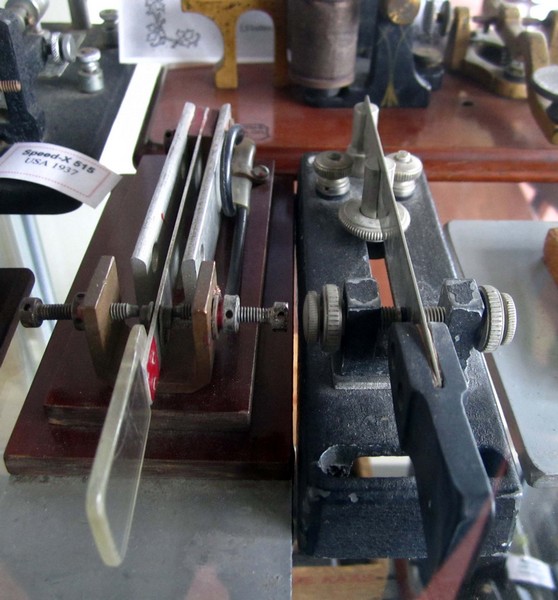 I gave the key a gentle clean and mounted it on a small iron ground plate for extra stability. It proved to be in full working order and is a delight to
use. I have now tried all of the three basic types of swiper: one with a stiff lever, attached to the pole with a flexible strip of metal (the Twanger,
which, of course also has flexible contacts); one with a stiff lever that is pivoted to the pole (the Jablonski); and finally one with a totally flexible
lever, like a hacksaw blade (the Maniflex). The hacksaw type feels best to me, but, of course, these things are personal.
I gave the key a gentle clean and mounted it on a small iron ground plate for extra stability. It proved to be in full working order and is a delight to
use. I have now tried all of the three basic types of swiper: one with a stiff lever, attached to the pole with a flexible strip of metal (the Twanger,
which, of course also has flexible contacts); one with a stiff lever that is pivoted to the pole (the Jablonski); and finally one with a totally flexible
lever, like a hacksaw blade (the Maniflex). The hacksaw type feels best to me, but, of course, these things are personal.
Further info on the Maniflex.
The video below shows PA3FOV / Jan operating my Maniflex in the Radio room of the Dutch aviation museum (Aviodrome) in Lelystad.
As a telegraphist for the KLM Jan used the side swiper on a daily basis. No film or audio files exist of original KLM side swiping, so we decided to make this video 'for history'. It was a joined project of PA0SKS (himself an ex-KLM telegraphist); PA3CNT (who edited the video) and myself, PA3CVV.
Jan told us that one day Maniflex keys suddenly appeared in the Lockheed Constellations of the KLM in the 1950s. No further instructions were given to the telegraphists, who only knew how to operate the straight key. So, they had to find out for themselves how to get CW out of these strange things. This might explain Jan's way of using the key. As you can see, he does not follow the conventional cootie method (always move from side to side) but regularly makes dits by tapping the thumb contact several times. It just goes to show that professionals had their own way of doing things.
The video is in Dutch, but I think this will not deter the true swiper enthusiast. [PA3CVV].
